So based on that uplifting first paragraph, you can probably guess where I'm going with this intro. The "country" we're visiting this week is officially known as the British Indian Ocean Territory, but historically this 23 square mile collection of six atolls and over 1,000 individual islands (most of them very small) is known as the Chagos Archipelago. It is located in the Indian Ocean, midway between Africa and Indonesia, and was settled by African slaves and Indian laborers who were brought to the islands in the 18th century for the purpose of building and operating coconut plantations. In the early 19th century, the UK captured Chagos and neighboring Maruitius, which was originally claimed by the French.
 |
| The Chago Archipelago, otherwise known as the British Indian Ocean Territory. |
For a while the islanders were allowed to go about their business, until the British decided that the Chagos Archipelago would be a good place to build a military base. After that, the UK government purchased and closed the plantations and then spent the next five years kicking 2,000 islanders out of their homes and off the islands. When it was finished, it dusted off its hands and then signed a nice little treaty with the US, leasing the Chagos Archipelago to the American military. All this happened between 1865 and 1871. No, wait … I'm 100 years off. This happened in the 1960s.
Yeah I had to blink too when I saw that date. This story is very reminiscent of the stuff that the British and the Americans used to do to native populations in the 1800s. Who knew it was still happening in the 20th century? This is modern history, and yet the British did a pretty fine job of keeping the whole endeavor quiet. My English husband didn't even know about it.
Today most of the exiled Chagos islanders are living in Mauritius and the United Kingdom, and for the most part they'd still like to go home. They've taken their case successfully to the English High Court, which ruled in 2006 that the Chagossians were entitled to return to their homeland. In 2009, however, the British countered by proposing that the Chagos Archipelago should be named a "marine preserve," which was a nice tidy way to tell the Chagossians to shove it, while of course maintaining military use of the islands.
Yes, this story ticks me off. But I guess I have to get on with the part about the food.
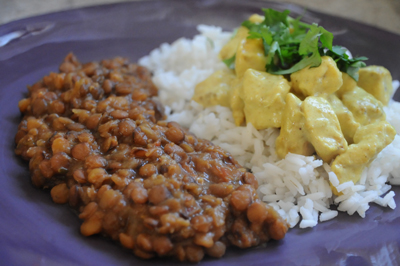 |
| The Chagos Archipelago: serrage poulet with a brown lentil seraz. |
Recipes from Chagos were predictably difficult to find. I had to rely on little clues I found in various places online, the first of which came from a website by the UK Chagos Support Association. In its news section I found a listing for an event where "Typical Mauritian and Chagossian food" would be served. The menu included a dish called "Serrage Poulet" (chicken in coconut milk).
Happily, I was able to discover a Mauritian recipe for Serrage Poulet fairly quickly, and since I'm told Maritian and Chagossian cuisine are more or less interchangeable, I figured this recipe would do:
Serrage Poulet (Chicken in Coconut Milk)
- 4 chicken breasts, cubed
- 2 cloves garlic, crushed
- 1" ginger root, grated
- 1 tsp turmeric
- 1/2 tsp garam masala*
- 1/4 tsp cayenne pepper*
- Salt and pepper to taste
- 1 tbsp cooking oil
- 1 14 oz can coconut milk
- 2 cinnamon sticks
- Handful of chopped cilantro
* Note: The original version of this recipe called for "spicy masala" of an undetermined amount. I chose to use a mixture of garam masala and cayenne pepper.
My next two recipes were a bit harder fought. They came from a French language interview with Olivier Bancoult, who is the leader of the Chagos Refugee Group. I was lucky enough to stumble upon this interview during my search, and was pretty happy to discover that the entire interview was about Chagossian food. Picking out a side dish recipe from what amounted to a very questionable translation required a little bit of detective work, but I eventually discovered that in Chagos "seraz"(which went untranslated) means "rougaille," and from there was able to track down a Mauritian recipe for a brown lentil rougaille, which is one of the dishes mentioned in the Olivier Bancoult interview. I was also lucky enough to find a partial recipe for a dessert in that same interview. Here they are, with my notes:
Brown Lentil Seraz
- 1 lb brown lentils
- 2 tbsp cooking oil
- 1 large onion, sliced
- 4 cloves garlic, crushed
- 1 tsp ginger, finely diced
- 3 large tomatoes, diced
- I sprig fresh thyme, crumbled
- 3 bay leaves
- Salt to taste
Notes: Olivier Bancoult specifically mentions coconut milk as a part of his brown lentil seraz, but I thought my meal was already pretty overwhelmed with coconut milk, so I left it out. If I was going to use it I would probably let the lentils boil in water until they were soft and the water was almost evaporated (about an hour and a half), then I would top the pot up with the coconut milk and let the lentils cook for another 20 to 30 minutes.
And finally the dessert:
Mouf
- 2 cups white rice
- Water to cover
- 1 cup coconut milk
- 1/2 cup sugar
- 2 large, square pieces of banana leaf
Note: All the measurements in this recipe are my guesses, because the Bancoult recipe didn't include them. I can't actually vouch for how accurate my version was, but I thought it came out beautifully. My mouf wasn't very sweet, though, so I've changed the sugar measurement from 1/4 cup to 1/2 cup in the recipe above.
The lentils take one and a half to two hours to cook, so I'll start there.
Now, the recipe says to soak the lentils for four to five hours, which of course I didn't do because I never actually read the recipe until after I'd already picked up my kids that afternoon. But in my experience, brown lentils don't really need to be soaked … a couple of hours cooking will usually get them where they need to be.
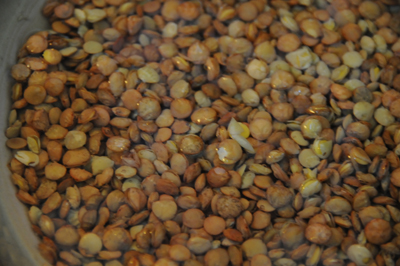 |
| If you have time, soaking the lentils for a few hours will make them cook faster. |
So first cook your onions in hot oil until they are soft, then add the ginger and garlic and keep cooking for one or two minutes. Add the tomatoes, thyme and bay leaves and continue to cook, stirring, until the tomatoes are soft.
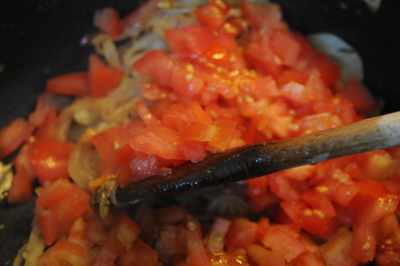 |
| Add the tomatoes. |
Add the lentils and enough water to cover. Bring to a boil, then reduce heat and cover. Simmer for 1 to 1 1/2 hours, topping up with water as necessary. You want your finished lentils to be more of a thick stew than a soup. Add salt to taste.
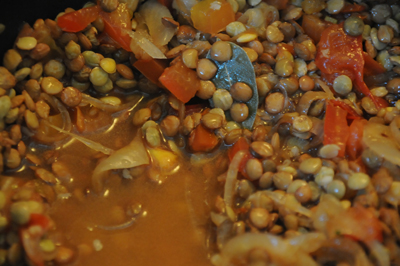 |
| Then add the lentils and cover with water. |
Now for the chicken:
Coat your chicken cubes with the seasonings.
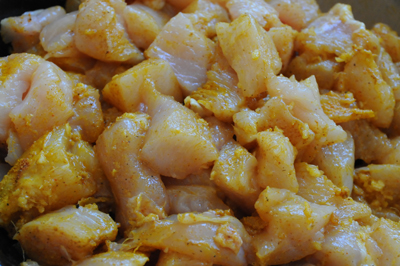 |
| Toss the chicken with the seasonings. |
Heat the oil over a medium flame, then add the chicken and cook until evenly browned.
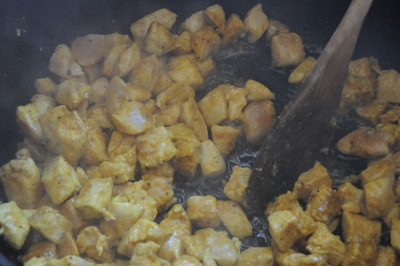 |
| Brown the chicken in hot oil. |
Pour in the coconut milk and add the cinnamon sticks. Bring to a boil, then reduce heat to a simmer and continue to cook until the chicken is heated through.
 |
| Add the coconut milk and simmer until the sauce has reduced. |
Serve over white rice, garnished with cilantro.
And finally the mouf, which has to be one of the top 10 weirdest things I've ever made for this blog. Simple, though.
First cover the rice with water and soak 30 minutes. Drain the water and transfer the rice to a food processor. Pulse until the rice becomes little beads.
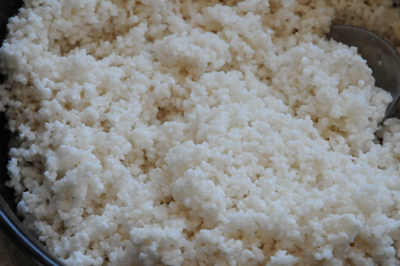 |
| The processed rice should look like tiny beads. |
Add the coconut milk and sugar and stir until you get a nice batter.
 |
| Add the coconut milk to make a batter. |
Now put your banana leaf on your work surface. If you've never worked with banana leaves before, I wish I could tell you how to do it, but I can't, because I have no idea. My banana leaves came from eFoodDepot, which I can sadly no longer recommend for a couple of reasons: 1) because I ordered a product from them that arrived in questionable condition and 2) because my last order took several weeks to arrive and came packed in what was clearly a second-hand cardboard box with crumpled up newspaper for padding, which just screams "someone's garage" and doesn't really give me a high level of confidence in the products I'm buying, especially given that they are imported exotic food items.
But anyway, I have these banana leaves, but mine were cracked and unable to contain the mouf batter, so I put them on top of a sheet of aluminum foil and hoped that the foil wouldn't stop the mouf from cooking properly, since banana leaves are porous and foil is not.
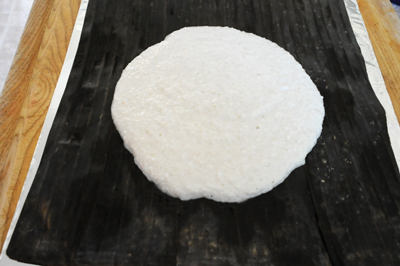 |
| Pour the batter onto the banana leaf. |
Anyway I wrapped up the mouf batter in the leaf and the leaf in the foil, then I submerged the entire packet in a pot of boiling water for about 30 minutes (at the end of 30 minutes, the mouf should be pretty soft. If the rice is still crunchy, put it back in for another 15 minutes or until done).
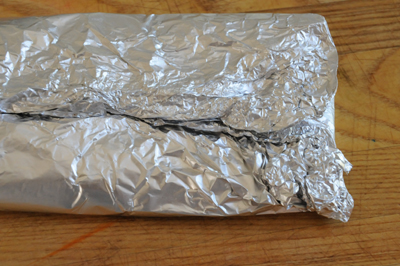 |
| I had to wrap mine in foil because my leaves were cracked. |
What I got after unwrapping the foil and leaves was an odd looking cake with a really interesting texture, which tasted great with honey (I don't think that's the traditional way of eating it but it sure worked for me).
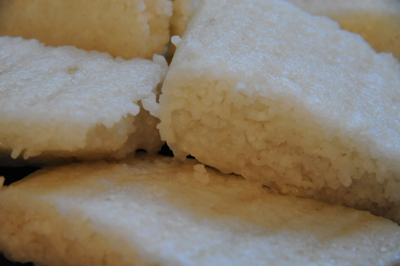 |
| Slice the mouf into pieces and eat plain or with honey. |
This meal was actually hugely popular with my children, once they got over the horror of being asked to eat green chicken (it was yellow, actually, but there's no arguing with gradeschoolers). Dylan moaned over his until long after the rest of us were finished eating, then sheepishly brought me a clean plate and admitted that he'd loved the entire meal. Martin and I enjoyed it too, and I'm not sure there's anything I would actually change about it if I made it again.
The mouf was a huge surprise. I didn't actually try it out on my kids because I'm fairly sure they wouldn't have been interested, and I didn't even think I'd be interested, to be honest. But there was something about the texture and the mild coconut flavor that was really delicious. Kind of addictively delicious, actually. I kept going back for more. As I mentioned earlier, I had mine with honey (probably not traditional), but I suspect it wouldn't have needed the extra sweetener if I'd got the sugar amount correct the first time.
So that's Chagos/The British Indian Ocean Territory, and although the food was good I can't say it had as much impact on me as the history of the place. But this blog isn't really about my political opinion, so I'll just stop there.
Next week: British Virgin Islands
For printable versions of this week's recipes:











0 comments:
Post a Comment